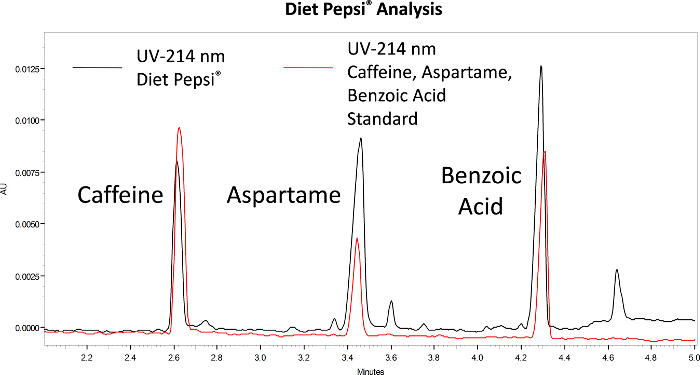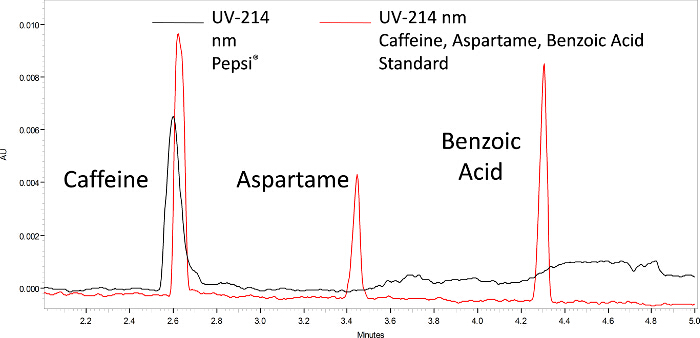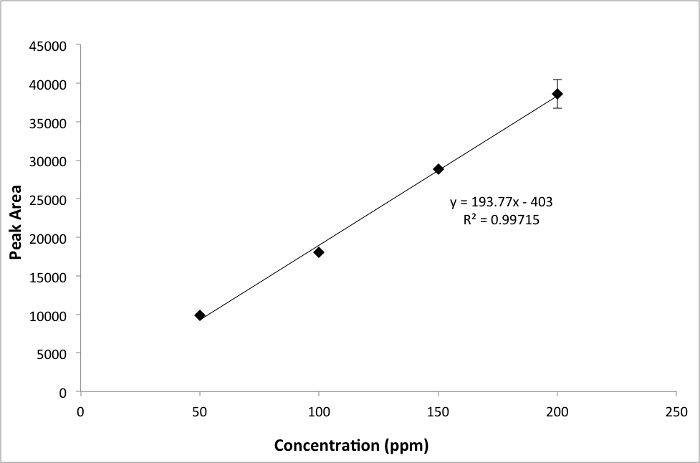キャピラリー電気泳動 (CE)
概要
ソース: 研究所博士 b. ジル Venton - ヴァージニアの大学の
キャピラリー電気泳動 (CE) は、サイズや料金に応じて電場内の分子を分ける分離手法です。CE は、電解質溶液で満たされている毛細血管と呼ばれる小さなガラス管で実行されます。検体は、電荷、溶媒の粘性およびサイズによって異なります電気泳動移動度の違いにより区切られます。伝統的な電気泳動のゲルはゲルと分離、ジュール加熱効果が台無しになるので適用できる電圧の量に制限します。毛細血管表面区域の容積比が大きい、従ってよりよい熱を放散します。キャピラリー電気泳動実験のため適用される電圧が非常に大きいため、多くの場合 10,000-20,000 V。
キャピラリー電気泳動の高性能版の役に立ちます。液体クロマトグラフィーと比較して、CE 版より速くより効率的。ただし、キャピラリー電気泳動に最適荷電分子を分離させて液体クロマトグラフィーの制限ではないです。CE は高速液体クロマトグラフィー (HPLC) よりも大きいピーク容量分離はより効率的でありより多くのピークを検出することができますを意味します。インストルメンテーションは、非常に単純なことができます。ただし、高速液体クロマトグラフィーより汎用性と多くの固定とモバイルの段階は、分子の種類によって開発されています。
原則
キャピラリー電気泳動は、電気泳動移動度による分子を分離します。分子の電気泳動移動度は、その電荷とどのくらいそれを集めて、電圧だけでなく、動きに抵抗する摩擦抵抗力による反発によって異なります。摩擦は分子の半径に比例します。したがって、電気泳動移動度はサイズや料金に基づいています。キャピラリー荷電分子移動速度は電気泳動の移動性と電界の製品です。したがってより高い電圧はより高速な速度、高速分離に します。
ほとんどのキャピラリー電気泳動装置は、検出器の端に負電圧と入口に正の電圧設定されています。これは負荷電の分子は、他の方法を移行しながら荷電分子を最後に、カソードに向かって移行することを意味します。ただし、すべての分子が検出器で見られる電気浸透流と呼ばれる流体のバルクがあるので。マイグレーション順序は、正荷電、中立的なそして、負荷電の分子です。
電気浸透流は、食塩水で満たされた小さなガラス管に高電圧を印加するが原因です。塩の溶液に正荷電イオンは、ガラスの壁に負荷電のシラノールの二重層を形成します。毛細血管の終わりに負の電圧を適用すると、それは摩擦力のために周りのソリューションも引っ張る二重の層から陽イオンを引っ張る。流れのこのタイプは、プラグの形、少ない帯域改善高速液体クロマトグラフィーの放物線状の流れプラグよりもにつながります。
中性分子すべては電気浸透流と同じレートで流れます。ただし、擬似固定相は分子のうちでパーティション分割できるフォーム ミセルに実行バッファーに追加できます。典型的な擬似固定相はドデシル硫酸ナトリウムです。ミセルは、外側に負荷電ミセル中で費やされた時間は、移行時期を判断しますので、彼らは電気泳動の移動性を持っているので。キャピラリー電気泳動のこの形態はミセル動電クロマトグラフィー (MEKC) と呼ばれます。
CE で検出高速液体クロマトグラフィーと同様です。紫外-可視は一般的であり、分子は二重結合を持っている限りのタグ付けを必要としません。ただし、吸光度が 50 μ m の細管用の小さいパスの長さによって異なります。バブル セルまたは z セルは、パスの長さが増加します。レーザー誘起蛍光法より敏感な検出方法です。レーザーは毛細血管と測定製品の蛍光のウィンドウを介して輝いていた。蛍光は、非常に高い感度を提供します、ほとんどは蛍光ではないために、タグに分子通常必要があります。電気化学検出とエレクトロ スプレー質量分析検出は人気で得ています。これらの検出器のいずれかの問題は、電気化学およびエレクトロ スプレー電圧の適用が必要し、CE 電圧に干渉することができます分離からの高電圧を検出する前に地面に提起しなければならないです。デカップリング CE の電圧、電流または、毛細血管の微小き裂を排出する電極を使用しての新しい方法は、これらの課題を克服します。
手順
1. CE の計測セットアップ
- CE 楽器とコンピューターを入れます。コンピューターのソフトウェアを使用して、ウォーム アップを許可する UV 分析用光源をオンします。いくつかのソフトウェアは、インジケーター ランプ使用の準備ができて (ランプ アイコン色に変わります)。
- 方法ファイルを作る。CE を実行するための重要なパラメーターを設定します。この分析でカートリッジとサンプルの保管温度は 35 ° c. です。UV 検出のための波長は 214 nm。
- 時間プログラムを書きます。プログラムは一般的に、(解析の前にキャピラリーをきれい) にリンス手順、注入の手順、および、電気泳動のステップで構成されます。リンス ステップ 20 psi の圧力を使用して 1 分の 2 洗口液を実行します。最初のリンスは、水酸化ナトリウムは、毛細血管壁にシラノール基が脱プロトン化したかどうかを確認できます。2 回目のすすぎは、実行バッファー (0.025 M ホウ酸バッファーここ) と毛細血管を確認するは左が平衡バッファーです。
- 注入圧注入 0.5 psi で使用は 5 s。
- 電気泳動のステップのための条件、分離電圧: 20 kV、時間: 5 分、通常の極性。各ステップの入口であり、どのバイアルはコンセントがバイアルをまた示します。すべてのパラメーターを入力した後方法ファイルを保存します。
2. 標準およびソーダ サンプルの準備
- アスパルテーム、カフェイン、安息香酸の 500 ppm 原液を水にします。容積測定フラスコを使用して、それぞれの 50 mL を作る。
- 150 ppm アスパルテーム、カフェイン、150 ppm、100 ppm 安息香酸標準液を 10 mL のメスフラスコに作る。
- 10 mL のメスフラスコで 50 ppm、100 ppm、150 ppm と 200 ppm の標準カフェイン溶液を作る。
3. CE のサンプルを実行します。
- 試料バイアル ホルダーに標準またはソーダのサンプルのいずれかを含むバイアルを配置します。どのサンプルがどのスロットにダウンを記述することを確認します。2 つのスロットがあるホウ酸バッファーと 0.1 M 水酸化ナトリウム洗浄液を実行します。
- 方法ファイルの最初のサンプルのバイアルは、スロットを入力します。
- 取得単一の実行、プログラムすべての情報を入力するように要求します。
- 各サンプルの入力のバイアルを変更するデータの獲得を続行します。標準の組み合わせ、カフェイン 3 濃度とペプシを実行し、ダイエット ペプシ サンプル。
- 楽器にターゲットを挿入し、適切な計測器を選択します。
- コンピューター上のデータを分析します。ピーク面積とオーバーレイ標準およびピークを識別するのに役立つ実際のサンプルを計算します。カフェイン データの検量線を作る。
結果
ダイエットペプシのエレクトロフェロを収集し、ペプシのサンプルはそれぞれ図 1 2に表示されます。安息香酸、アスパルテーム、カフェインの 3 つのピーク、ダイエットペプシで観察され、基準として同様の移行時間を持っています。正規のペプシのカフェイン ピークがアスパルテームと安息香酸のピークではないことがあります。CE 解析は、移行時間が 3-4 分だけ高速です。
カフェインの検量線を図 3に示します。この曲線は、各サンプルに含まれるカフェインの濃度を計算する使用できます。

図 1。ダイエットペプシの CE 解析します。赤は、安息香酸、アスパルテーム、カフェインの規格です。黒は、ダイエット ペプシ サンプルです。この図の拡大版を表示するのにはここをクリックしてください。

図 2。ペプシの CE 解析します。黒はペプシ サンプル赤は安息香酸、アスパルテーム、カフェインの基準のサンプルです。アスパルテームがないかを示す、ソーダの安息香酸はダイエットではないです。この図の拡大版を表示するのにはここをクリックしてください。

図 3。CE とカフェイン校正プロットします。カフェイン標準ピーク面積対濃度のプロットは、CE で測定します。この図の拡大版を表示するのにはここをクリックしてください。
申請書と概要
キャピラリー電気泳動は、多くの専門の版のために使用されます。たとえば、品質の製品または接しないがないかどうかを確認するテストのため製薬業界で使用それ。CE は毛細血管の壁は、酸性 pH を有する中立的な作ることができる従って薬毛細血管に固執しないと基本のアミノ グループと薬を分離する場合に特に便利です。
CE のモードは、ヒトゲノム DNA を分離しても使われました。CE のこのモードはキャピラリー電気泳動と CE キャピラリーにセパレーションこれらのポリマーを注入します。ポリマーより小さいフラグメントはゲルを通って速く移動することができます、サイズに基づいて分離の追加モード。これを篩分法と電気泳動分離と共にそれは DNA 分析のための 1 の塩基対解像度。
スキップ先...
このコレクションのビデオ:

Now Playing
キャピラリー電気泳動 (CE)
Analytical Chemistry
94.5K 閲覧数

試料分析の準備のため
Analytical Chemistry
85.2K 閲覧数

社内基準
Analytical Chemistry
205.4K 閲覧数

標準添加法
Analytical Chemistry
320.8K 閲覧数

検量線
Analytical Chemistry
798.7K 閲覧数

(紫外-可視) 紫外可視分光法
Analytical Chemistry
625.2K 閲覧数

ラマン分光を用いた化学分析
Analytical Chemistry
51.4K 閲覧数

蛍光 x 線 (XRF)
Analytical Chemistry
25.9K 閲覧数

炎イオン化検出ガスクロマトグラフィー (GC)
Analytical Chemistry
283.1K 閲覧数

高速液体クロマトグラフィー (HPLC)
Analytical Chemistry
386.0K 閲覧数

イオン交換クロマトグラフィー
Analytical Chemistry
265.1K 閲覧数

質量分析への紹介
Analytical Chemistry
112.9K 閲覧数

走査型電子顕微鏡 (SEM)
Analytical Chemistry
87.6K 閲覧数

ポテンショスタット/Galvanostat を使用して担持触媒の電気化学測定
Analytical Chemistry
51.8K 閲覧数

サイクリックボルタンメトリー (CV)
Analytical Chemistry
126.0K 閲覧数
Copyright © 2023 MyJoVE Corporation. All rights reserved